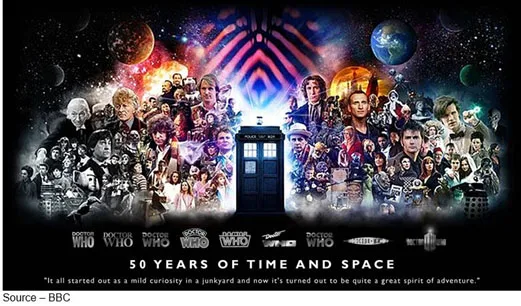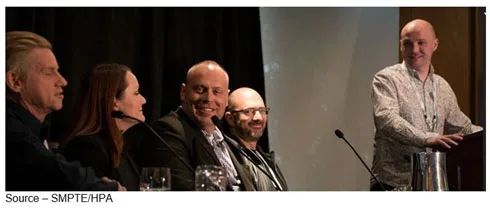The Stuff That Makes Your Entertainment Enjoyable

Remember when you used to plan a week in advance for a night at the movies or ran home because you just had to watch something/anything on TV?
Yeah, me neither!
The content world has gotten huge, complex; and the demands/expectations have become excruciating.
At MWC (Mobile World Congress) in Barcelona, booth people talked about how 5G technology was going to let them give what they swear consumers wanted … breathtaking video content to any screen a person had in his/her hands.
On almost the other side of the globe, industry production/post folks sat through session after session for five days at the HPA Tech Retreat. They were more practical focusing on how to make it better, faster for them to produce, distribute and make money in a world gone mad for content.

Far from the glitz and glamour of CES and MWC, production managers and engineers were “isolated” in deep techie discussions in Palm Desert, CA.
Standards, recommended practices, and engineering guidelines like ATSC (Advanced Television Systems Committee) 3.0, HDR (high dynamic range), ACES (Academy Color Exchange System), HFR (high frame rate), and IMF (Interchange Media Format) aren’t as breathtaking as the latest tentpole release; but they’re what make movies, TV shows and video content look better, feel better, be better.
Standards like ATSC 3.0 are part of the industry’s response to BitTorrent and other pirate sites that share bad copies of great content over the internet. While pirate downloads can potentially include malware and are messy to access, ATSC 3.0 won’t eliminate the practice some feel is fun or their right. It did allow folks to watch the Winter Olympics in 4K – assuming their TV could handle it; and it will be rolled out globally as IP TV transmission becomes standard.
People are already exploring how they can make advertising more targeted/more germane for the viewer; even letting them buy directly from the ad … the ultimate test of content and the ad!
During the HDR session and offline, everyone agreed that understanding the beauty, depth of color and superiority of HDR content isn’t rocket science.
Of course, agreeing on one of the HDR flavors and getting it to be a standard for everything that is shot, produced, and shown will take time.
Screen folks complain that there isn’t enough HDR content; so selling big, beautiful screens is difficult. Content people counter that there aren’t enough screens to warrant the extra work.
LG didn’t choose sides on the little format scuffle. Instead, they focused on selling screens they support all four.

Sidestepping the question of which is better; Dolby Vision or “the others;” Pat Griffis, Dolby VP of Technology, said the basic definition of HDR is more accurately characterized as color volume and that HDR has made more colors available, not just contrast but brightness.
While several panelists cited the added cost of shooting/production in 4K and HDR; Jimmy Fusil, Netflix manager of production technologies, disagreed, noting that in their experience, the cost was nominal.
In the Innovation Zone (demo area); Greg Barrett, Netflix Manager of Digital Production Assets & Delivery, told us they expected everything in 4K (unless it is spectacular) and that HDR would deliver more bang for the buck than 8K.
Of course, Netflix never lets its catalog stagnate by recoding titles based on the complexity and by stepping up to the AV1 codec that will improve quality later this year to enable streamed video while cutting bandwidth by at least 50 percent.
Despite all of the 8K trials and optimistic projections, Griffis agreed with Netflix’s observation that combining HDR and 4K will be streaming for 5-10 years before the world converts to 8K. Having pushed the floodgates open, Netflix’s focus is on delivering a large volume of product to audiences around the globe.
Of course, what Netflix is testing in their futures labs may again change the course of the industry!
Sometimes, the ecosystem can’t seem to get out of its own way and more live content like the recent Olympics will help filmmakers want to deliver the most dynamic picture possible while consumers push for commodity screens that deliver all of the HDR flavors.
Hey, we can hope!
One of the biggest issues facing the HPA Retreat attendees and the global M&E industry is the rising demand for content on any/every platform and the ability to keep track of all the versions.
I understood the growing issue but zip about IMF. However, if Clyde Smith, Senior Vice President at Fox Network Engineering and Operations, brought together a panel session on IMF, it had to be important.

Andy Wilson, the UK’s DPP (Digital Production Partnership) head, noted that for the BBC’s 50th anniversary, the 77-minute episode of Dr. Who used 70TB storage for all of the versions, which made Larry O’Connor, CEO of OWC Digital, smile.
The smile faded when Wilson pointed out that if they had used IMF, the total storage would have only been 4TB.
It’s a good thing people are producing more content.
Wilson noted that versioning is becoming a major challenge for content producers and distributors as well as advertisers because the content needs to be ready for showing at theaters and over appointment TV channels as well as OTT to TV sets, computers, tablets and smartphones.
“IMF eliminates duplication while retaining process knowledge and preserving mastering quality end-to-end,” he continued. “Production has one format, one master that speeds content marketing and future-proofs the assets for the future.”
Taking the complexity out of IMF, Wilson explained that IMF delivers cost efficiencies by automating the content supply chain, eliminating the need for multiple versions, enabling greater workflow efficiencies and reducing QC costs.
Sounds like a helluva’ good idea!
There’s always a lot of positioning discussion about the next great thing for films/shows at the Retreat that companies say will do a better job of delivering the creative team’s intent.
But the biggest challenge for producers has become the challenge of keeping track of the data of each frame, color point and pixel—the metadata.
With production people staring at all of the versions and formats, content metadata and automating the process is becoming increasingly important to the HPA Retreat attendees and the filmmaking community.
And now the industry is even developing standards and guidelines for downstream image presentation management – how it looks on your screen.

Staying true to the creative intent of the project ultimately relies on one thing–content metadata.
Phillip Hodgetts, President/CEO of Lumberjack Systems and Intelligent Assistance Software, is one of the few people we know who can actually make metadata sound interesting.
“By introducing sound AI technology into the workflow process, we can more consistently, more quickly and more economically,” he explained. “And, we can ensue that the material the viewer sees is exactly what the artist intended, regardless of the screen or how long it has been archived before it is reintroduced.
“Repurposing and releasing films from 30, 20 and even 10 years ago is a very time-consuming, expensive process,” he continued. “But with today’s metadata analytics technology and even our rudimentary AI technology, it’s faster, better and truer to the filmmaker’s intent.
“Tomorrow it’s going to be even better … guaranteed!” Hodgetts added.
Of course, no HPA Tech Retreat would be complete without an intense discussion of content production and delivery in the cloud.
During the session on production in the cloud, Matt Thomas, VP of sales at SHIFT, said that the use of the cloud is evolving rapidly. He emphasized that hybrid solutions and new services by Adobe, Avid, Dolby and others are being used by a growing number of production and post experts.
Unfortunately, he passed right over the continuing workflow challenges like bandwidth, sizing, caching and the ugly fact that cybercrime – theft of content – is a growing challenge for even the best security teams.
But we feel he missed the important reason most production/post work remains local and passes through the cloud as little as possible.
There’s just something about a filmmaker, editor, FX creative or audio expert being able to wake up in the morning, reaching over and patting his content work on his or her local storage.
That peace of mind for today’s filmmaker is hard to replace with a few more bucks in his/her pocket.
 As the Alien observed, “you have your mother’s hands… You’re an interesting species, an interesting mix. You’re capable of such beautiful dreams and such horrible nightmares. You feel so lost, so cut off, so alone, only you’re not. See, in all our searching, the only thing we found that makes the emptiness bearable, each other.”
As the Alien observed, “you have your mother’s hands… You’re an interesting species, an interesting mix. You’re capable of such beautiful dreams and such horrible nightmares. You feel so lost, so cut off, so alone, only you’re not. See, in all our searching, the only thing we found that makes the emptiness bearable, each other.”
The technology behind all of that content is important to the viewer–even if he/she doesn’t know it.
# # #